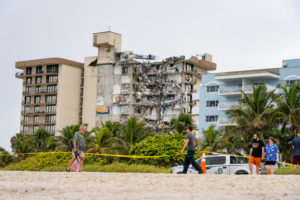
The Federal Emergency Management Agency (FEMA) established the National Urban Search & Rescue Response System in 1989. Engineers started serving on urban search and rescue teams the following year.
Disasters such as earthquakes, tornados, and bombings may cause structures to collapse. Engineers help keep victims and first responders safe by analyzing the remaining structure and shoring as necessary so it doesn’t collapse further. They also determine where people are likeliest to have survived under the rubble. Engineers participated on FEMA teams following the 1995 bombing of the Murrah Building in Oklahoma City, the 2001 World Trade Center attacks, and the 2021 collapse of Champlain Towers in Florida. They have also traveled overseas following earthquakes in Haiti in 2010 and Japan and New Zealand in 2011.
Urban search and rescue teams deploy after major disasters when people are trapped, injured, or cut off from help. Certified, trained, and funded by the federal government, these US&R teams feature coordinated, multidisciplinary efforts that include civil and structural engineers who work alongside experts in fire/rescue, heavy equipment, canine search, emergency medicine, and other disciplines.—Caldwell and Riccitiello, Civil Engineering, May 2022
Engineers who want to serve in this capacity are usually mid-career professionals with experience in construction, demolition, or forensics. They need to be good communicators who are in good physical condition. And they need to be able to leave work and family on short notice.
Training engineers for urban search and rescue
FEMA and the US Corps of Engineers jointly provide specialized instruction for engineers who wish to serve on these teams. The necessary skills include tracing load paths in partial collapses, estimating dead loads from debris and rubble, and shoring to support those loads. There are also drills that simulate actual collapses. FEMA incorporates lessons from previous disasters into these drills.
Engineering is all about protecting the health, safety, and welfare of the public. Usually that means preventing disaster, not responding to it. So engineers tend to gather all the information and thoroughly analyze it before taking action. But in urban search and rescue there isn’t time for deliberation. They won’t have all the information they need when they need it. Lives are at stake, and time is of the essence.
Urban search and rescue teams are different from project teams. Instead of being in charge, the engineer is a technical advisor outside the command structure. The person in charge here will be a fire chief or a specialist in heavy rescue, hazardous materials, technical search, or logistics. The engineer must learn to respect the chain of command and be a team player.
FEMA task forces comprise four components:
- Search specialists find victims after a disaster.
- Rescue specialists extract victims, safely digging them out of the rubble.
- Technical experts include the structural engineers who make rescues safe for rescuers and victims.
- Medical specialists care for the victims before and after rescue.
Learning from experience
In addition to learning how better to respond to different kinds of disasters, engineers can take other lessons from urban search and rescue. Observations following earthquakes inform changes to building codes based on how well different building systems performed.
Similarly, what we learn from collapses due to terrorist attacks as well as natural disasters helps us prevent future disproportionate collapse. The first US consensus standard on disproportionate collapse is available as of June 2023. Disproportionate collapses such as those of the Murrah Building and the World Trade Center are, thankfully, rare. However, they can result in the loss of many lives. The failure of Champlain Towers may also have been a disproportionate collapse, but it’s too early to tell.
The new standard emphasizes performance, not prescription. It includes two design strategies. The first is to assume the removal of one or more significant load-bearing elements, such as columns. The design must provide alternate load paths. The second strategy is to isolate portions of the building from one another, for example through expansion joints. The latter might be appropriate in a long, low building where failure could propagate horizontally.
